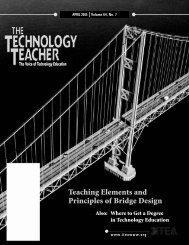K-12 Engineering Education Standards: - International Technology ...
K-12 Engineering Education Standards: - International Technology ...
K-12 Engineering Education Standards: - International Technology ...
Create successful ePaper yourself
Turn your PDF publications into a flip-book with our unique Google optimized e-Paper software.
e judged on accuracy, functionality, strength, neatness,<br />
and technical quality of the drawings and the prototype.<br />
Design teams will be evaluated on this project using the<br />
following criteria:<br />
1. Functionality: (30 points) Does the prototype device<br />
perform the intended function?<br />
2. Accuracy: (20 points) Does the prototype meet the<br />
stated criteria (i.e., store textbooks, notebooks, writing<br />
utensils, mobile phones, and various other items)?<br />
3. Strength and Durability: (20 points) Is the prototype<br />
strong and durable, and will it stand up to hard and<br />
constant use in a school?<br />
4. Technical Quality: (20 points) Is the original drawing of<br />
high quality, and was the prototype produced in a neat<br />
and clean manner?<br />
5. Originality: (10 points) Is the prototype an original idea,<br />
and does it incorporate innovations?<br />
6. Extra credit: (up to 5 points) Points will be awarded for<br />
the efficiency of the student’s work or “time on task.”<br />
Summary<br />
The Locker Design Challenge is a motivation assignment<br />
that allows for design creativity and student choice within<br />
the technology education classroom. The parameters of<br />
the challenge allow students to explore and experiment<br />
in a nonrestrictive environment, breaking away from the<br />
prescriptive methods employed in many CAD lessons. To<br />
introduce this lesson, it is recommended that the instructor<br />
bring in a variety of cardboard packaging and display items.<br />
These displays can be found at your local market or grocery<br />
store. Often these displays can be found at the end of an<br />
aisle holding batteries, magazines, and other highly visible<br />
items. These displays fold together and stand on their<br />
own. When students have the opportunity to manipulate<br />
different types of displays, they are better able to visualize<br />
how this type of package design works. This will aid in<br />
the surface development and pattern design of individual<br />
locker organizers.<br />
This design-based activity provides students with a practical,<br />
real-world activity in the CAD classroom. This is design with<br />
a purpose.<br />
Resources:<br />
Bhavnani, S. & John, B. (1996). Exploring the unrealized<br />
potential of computer-aided drafting. Proceedings of the<br />
‘96 SIGCHI Conference on Human Factors in Computing<br />
Systems. Vancouver, British Columbia, Canada. Retrieved<br />
from http://portal.acm.org/citation.cfm?id=238538<br />
Carter, V. & Daugherty, M. K. (2008). The challenge of design.<br />
Unpublished Manuscript.<br />
Cheng, Nancy Yen-Wen. (1997). Teaching CAD with<br />
language learning methods. In J. P. Jordan, B. Mehnert,<br />
and A. Harfmann (Eds.), Representation and design,<br />
proceedings of the Association for Computer Aided Design<br />
in Architecture (ACADIA) (pp. 1–19). Cincinnati, Ohio.<br />
Retrieved from http://darkwing.uoregon.edu/~design/<br />
nywc/pdf/acadia97-lang-cheng.pdf<br />
Clemons, S. A. (2006). Constructivism pedagogy drives<br />
redevelopment of CAD course: A case study. The<br />
<strong>Technology</strong> Teacher, 65(5), 19-21.<br />
Ferguson, E. (1994). <strong>Engineering</strong> and the mind’s eye.<br />
Cambridge: MIT Press.<br />
French, T. & Helsel, J. (2003). Mechanical drawing: Board<br />
and CAD techniques (13th ed.). New York: Glencoe-<br />
McGraw Hill.<br />
Hill, R. & Wicklein, R. C. (2000). Great expectations:<br />
Preparing technology education teachers for new roles<br />
and responsibilities. Journal of Industrial Teacher<br />
<strong>Education</strong>, V37 (N3), 6-21.<br />
Ivins, W. (1953). Prints and visual communication (p. 160).<br />
Cambridge, MA: Harvard University Press. Republished in<br />
1969, Cambridge, MA: MIT Press. ISBN 0-262-59002-6.<br />
Jordan, P., Di Eugenio, B., Thomason, R., & Moore, J. (1997).<br />
Reconstructed intentions in collaborative problem-solving<br />
dialogues. Pittsburgh, PA: University of Pittsburgh.<br />
Retrieved from http://www.isp.pitt.edu/~intgen/<br />
Kelley, T. (2001). The art of innovation. New York: Doubleday.<br />
Petroski, H. (1998). Invention by design: How engineers get<br />
from thought to thing. Topeka, KS: Tandem Library.<br />
Stipek, D. J. (1996). Motivation and instruction. In D. C.<br />
Berliner & R. C. Calfee (Eds.), Handbook of educational<br />
psychology (pp. 85–113). New York: MacMillan.<br />
Sheldon, K. M. & Biddle, B. J. (1998). <strong>Standards</strong>,<br />
accountability, and school reform: Perils and pitfalls.<br />
Teachers College Record, 100(1), 164–180.<br />
This is a refereed article.<br />
Michael K. Daugherty, Ed. D. is Professor<br />
of <strong>Technology</strong> <strong>Education</strong> and Department<br />
Head of Curriculum and Instruction at the<br />
University of Arkansas in Fayetteville, AR.<br />
He can be reached via email at mkd03@<br />
uark.edu.<br />
Vinson Carter is a Visiting Instructor of<br />
<strong>Technology</strong> <strong>Education</strong> in the Department<br />
of Curriculum and Instruction at the<br />
University of Arkansas in Fayetteville, AR.<br />
He can be reached via email at vcarter@<br />
uark.edu.<br />
8 • <strong>Technology</strong> and <strong>Engineering</strong> Teacher • February 2011
















